How to Secure a Trampoline In High Winds: [3 Best Methods]
What’s the number one enemy of trampolines? Answer – the weather.
Since a trampoline is typically kept outdoors most of the time, it’s at the mercy of nature. And because of that, it needs to tackle snow, rain, and extreme heat all at the same time.
One thing I love about modern trampolines is that they usually come with a UV-coated frame that prevents sun or rain damage to a pretty decent extent. And during snowy seasons, you can simply disassemble and store away your trampoline since nobody is likely to use it at the time anyways.

But that still leaves out the issue of high wind. If you live in a windy region, there’s always a risk of your trampoline getting blown away by a strong gust of wind. I’ve seen that happen, and it’s never pretty for anyone. A trampoline blown away by a rogue gust of wind can cause a lot of damage around the neighborhood.
So, what’s the solution? How do you make sure your trampoline stays secure even when the wind picks up? Well, there are a couple of solutions here. And in this article, I will address all your options to help you secure your trampoline during high wind. Let’s get started.
How to Secure Your Trampoline Against High Wind
The best way to protect your trampoline from blowing away is to secure it to the ground. And there are a couple of ways to do it, some of them permanent, and some of them – not as much.
Here are some of the ways you can secure your trampoline against high wind so that it doesn’t turn into a menace and fly through your neighborhood.
1- Using a Trampoline Anchor
The best way to anchor your trampoline to the ground is by using some sort of trampoline anchoring kit. You have two options here.
Firstly, you could go with the standard U-shaped anchors that come for free with most trampolines. Or you could also go with corkscrew-style augers, that you can buy from any local trampoline store.
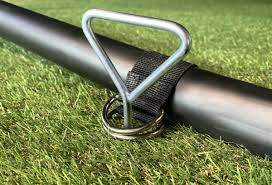
There are some differences between them though, so let me talk a bit about the two of them to help you figure out which one’s better for you.
U-Shaped Anchors
U-shaped anchors are also called wind stakes, and they offer a basic layer of safety for your trampoline against strong winds. This type of anchoring kit often comes as a free gift with many high-quality trampolines. Installing a U-shaped anchor is easy, and its performance is pretty reliable.
To install U-shaped anchors, start by getting the ground around your trampoline wet. Then you will position the stakes over the trampoline leg so that when you hammer it into the ground, it locks the leg in place. You should go with at least two stakes per leg to make sure your trampoline remains firmly rooted to the ground.
So that means if your trampoline comes with four legs, you need at least eight wind stakes to keep it secure. Wind stakes are easy, affordable ways to protect your trampoline against high winds.
Corkscrew-Style Augers
Corkscrew-style augers are considered the more secure way to anchor your trampoline. It often comes as a set of four. For most round backyard trampolines, four auger-style trampoline anchors are enough. But if you have a larger trampoline, then you might want to invest in an extra set.
Instead of hammering the augers into the ground, you need to, well, screw them into place by twisting the top part. Then use the elastic strap that’s included with the package to loop it around the trampoline frame and attach it to the auger keeping it tight and secure.
The advantage of this type of anchor is that you can simply unfasten the strap if you ever want to move the trampoline. And unscrewing the auger stake is also pretty easy. So, you can change the position of your trampoline without any hassle when you use this type of anchoring kit.
Regardless of the type of anchoring kit you prefer, as long as you invest in a nice, sturdy pair of it, you should be fine. I recommend installing the trampoline anchors when you first set up your trampoline.
2. Using Sandbags
Investing in a nice set of trampoline anchors is always the way to go if you want to make sure your trampoline remains safe during heavy winds. But if you don’t want to for some reason, and if you have a couple of sandbags in hand, then you could use it as a temporary solution.
Sandbags are heavy, and if you put a couple of them on each leg of the trampoline, it’s not going anywhere. And once the storm clears, you can remove the sandbags and use the trampoline as normal.
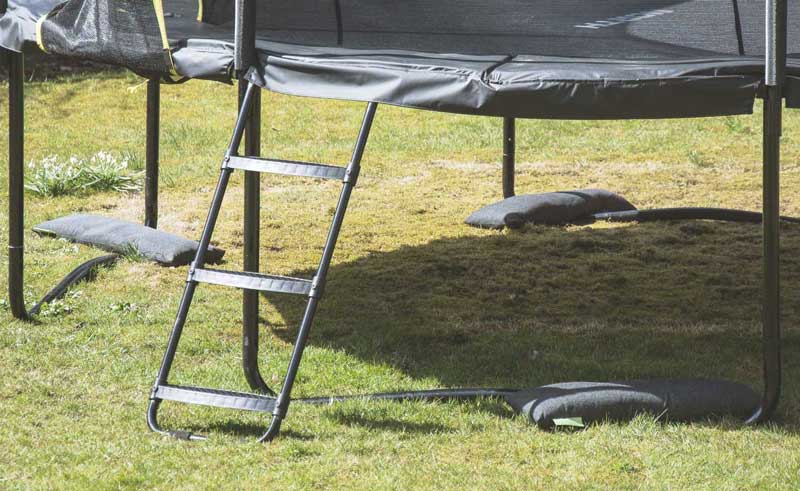
If you are planning to go with this option, make sure you are placing enough sandbags on each leg to keep the trampoline firmly planted on the ground. If there’s any wobbling in the trampoline after putting the sandbags, that means you need more of it.
While it’s a clever solution to secure your trampoline during high wind, this is not as secure as wind stakes or trampoline augers. It might be enough as a quick and easy fix to the problem, but I would still recommend investing in a high-quality trampoline anchor set to safely tether your trampoline to the ground.
3. Using Leg Bolts or Wraps
If you put your trampoline on concrete, which I really don’t recommend, or similar hard surfaces, then sandbags might not be enough to keep it secured against high winds. And breaking through concrete to install a trampoline anchor isn’t really an option either. So, what’s the solution?
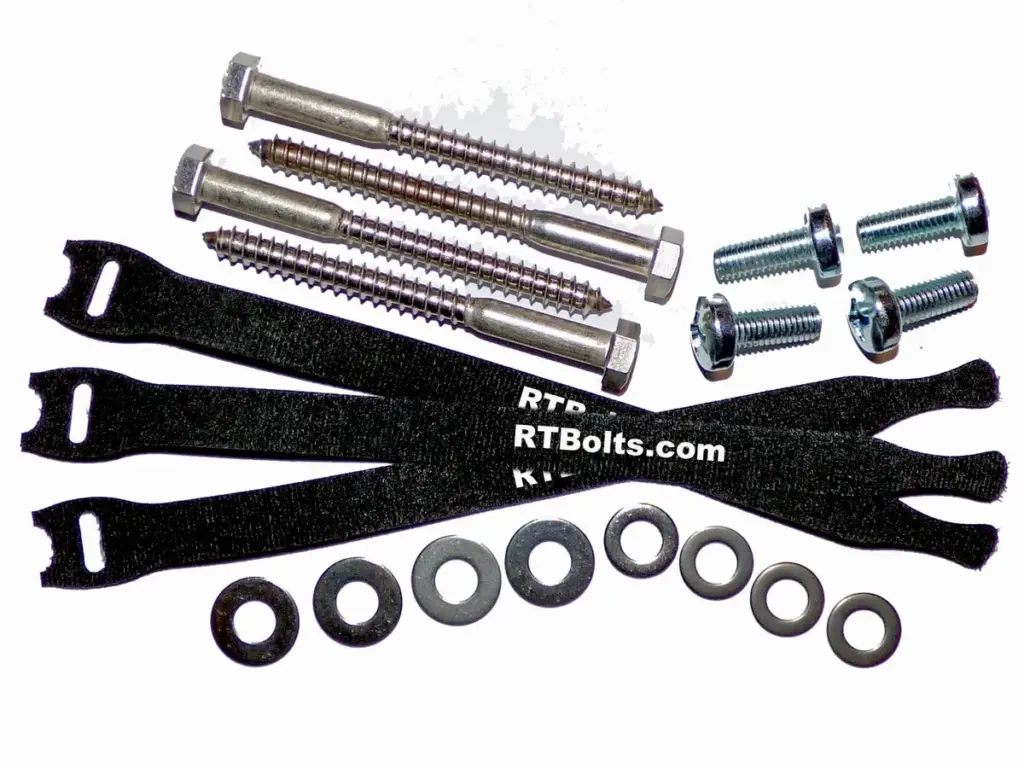
Instead of going with the traditional trampoline anchors, what you want are leg bolts. While they are, in principle, the same as corkscrew-style augers, they are strong enough for you to drive them through concrete using a power drill.
Once you drill them onto the concrete surface, use the included straps to lock your trampoline in place. Again, I don’t recommend placing your trampoline on concrete, but this is a valid way to anchor it if you don’t have any other option.
Securing Your Trampoline: How Important is it?
I’m sure you’re wondering how a gust of wind is enough to blow away your trampoline that’s made of stainless steel frame. Well, yes – trampolines are pretty heavy, but their weight alone isn’t enough to keep them rooted to the ground when the wind picks up.
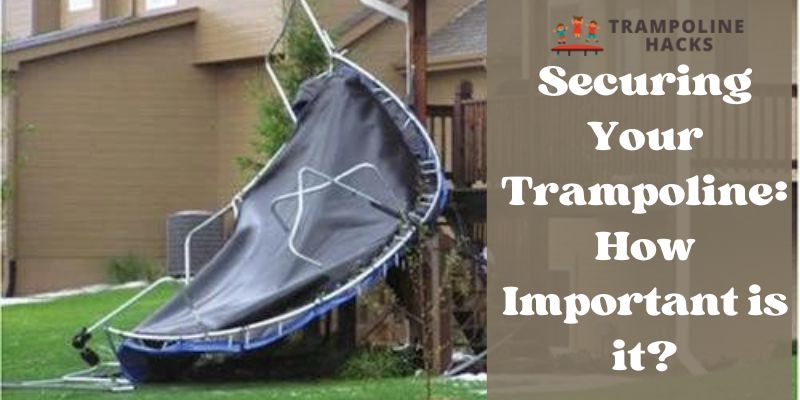
You see, the elastic jumping mat in the trampoline can act like an air trap. And when the wind picks up, air can get trapped in the mat, similar to how the wings work on a bird. When the wind is strong enough, it can easily lift up and blow away your trampoline.
While some states are more prone to heavy wind than others, the truth is, you can’t really predict the weather with a hundred percent certainty. And even if you can, there’s no guarantee that you’ll have the chance to anchor your trampoline when you detect the wind picking up.
That’s why I would recommend all trampoline owners to anchor their trampoline securely to the ground during the initial setup. It doesn’t take too long, and most trampolines include a free trampoline anchoring kit when you buy them. Even if your trampoline doesn’t come with an anchoring kit, an aftermarket one shouldn’t cost too much.
How to Protect Your Trampoline During a Hurricane
Putting up trampoline anchors to tether your trampoline to the ground is a must to protect it against strong winds. But when you’re dealing with natural events such as a hurricane, trampoline anchors are not enough to ensure your trampoline’s survival.
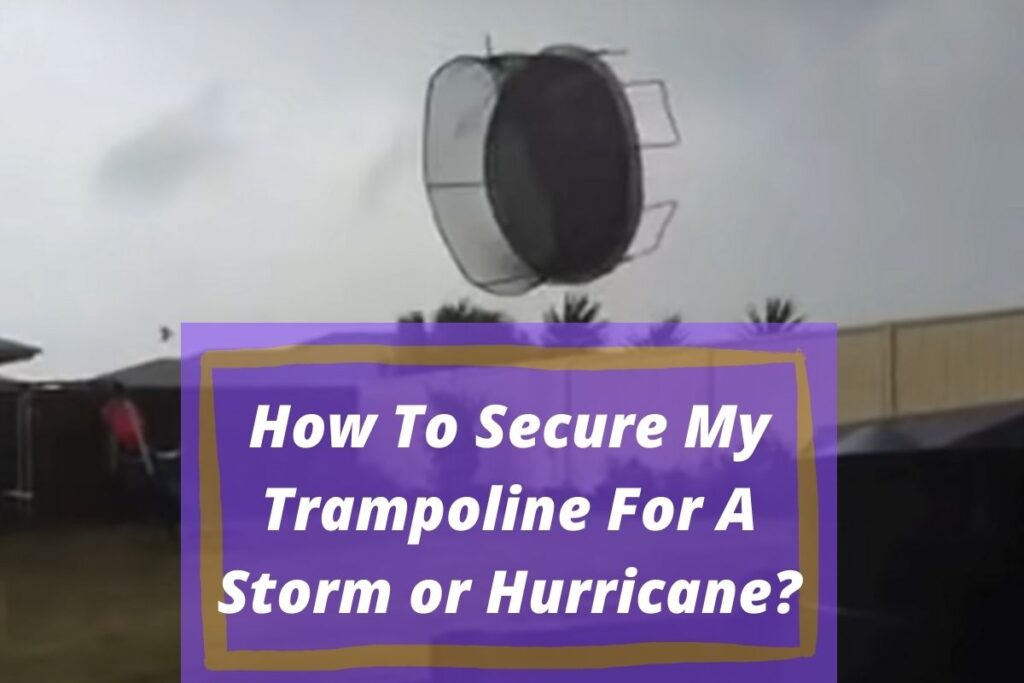
It’s still important, but there are a couple more things that you must do here.
So, let’s talk a bit about what you should do to protect your trampoline when there’s a hurricane coming your way.
First off, disassemble the enclosure net, and take down the enclosure posts. You should store the enclosure posts in your tool shed or inside the house.
If possible, move the trampoline to a more secure location, preferably inside the house. But then again, that might not be an option for people who have a large trampoline. In that case, try to get it between trees or beside the shed.
Flip the trampoline upside down and place a large tyre or sandbag to hold it down.
If you have a corkscrew-style auger, use some additional ropes to give it a bit of extra security.
As long as you follow the steps above, your trampoline should be fine. But in any case, I would still recommend disassembling the trampoline and moving it indoors if you have the option.
How to Minimize Wind Effects on Your Trampoline
If you keep your trampoline in an open place, strong winds will have a greater effect on it. The risk of it blowing off when the wind picks up will be a lot less if there are other objects around the trampoline to block off the wind.
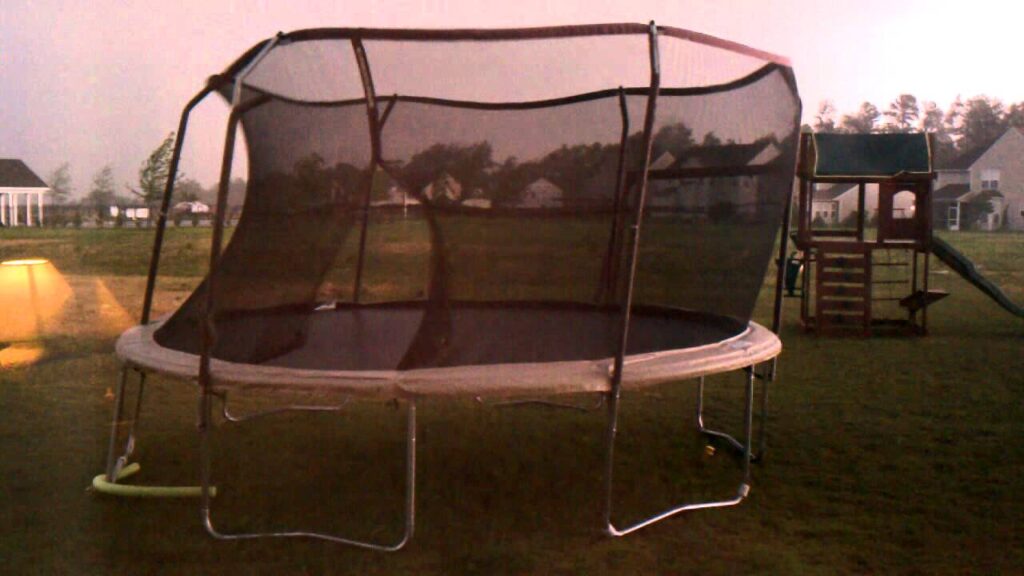
By objects, I’m talking about standard backyard stuff such as trees, fences, or even small porch decorations are often enough to reduce the intensity of the wind. However, if you’re dealing with a tornado, then relying on other objects to protect your trampoline isn’t really a wise idea.
To protect against tornadoes or hurricanes, you need to follow the steps that I talked about earlier. But in my experience, it’s better to just disassemble and store the trampoline away if you get a tornado warning. As long as you have enough time to respond to the situation, that is the best approach.
But if you live in an area where strong wind is a daily incident, then using a trampoline anchor to secure it to the ground is the only option if you want to keep a trampoline in your backyard. You can also put up fences around your backyard to reduce the intensity of the wind that reaches your trampoline.
Are Trampoline Anchors Expensive?
While a decent trampoline will often cost you a pretty penny, the price you have to pay for a high-quality trampoline anchoring kit isn’t really that much. So that’s not a valid excuse for not using trampoline anchors to tie down your trampoline when you live in a windy region.
Generally, a wind stake or U-shaped trampoline anchor costs less than a corkscrew-style auger kit. But if the wind speed in your region exceeds 40 miles per hour on a regular basis, I would still recommend investing the extra few bucks for an auger-style trampoline anchor. It’s safer and much more reliable.
A typical U-shaped trampoline anchor will cost you around 10 to 30 bucks. And if you’re going with an auger-style trampoline anchor, it shouldn’t cost you more than 30 to 60 bucks. It’s a small price to pay for the safety of your trampoline and your neighbors.
Now That We’re Here
At the end of the day, keeping your trampoline safe in your neighborhood is your responsibility. And securing it with wind stakes or trampoline anchors is the least you could do to ensure it doesn’t blow away.
If your trampoline gets blown away, not only will your trampoline get damaged, it will also wreak havoc in your neighborhood. And in most cases, insurance won’t cover those costs. They’ll have to come right out of your own pocket.
I hope my in-depth guidelines on how to secure a trampoline during high wind could help you keep your trampoline firmly planted where you first set it up. Good luck!
Hi, It’s Jason and Louise here and welcome to our website. We are parents to Hannah and Zachary who absolutely love the outdoors and are actually addicted to jumping on their trampoline. Our amazing little family lives on a beautiful 20-hectare rural property with Horses, Dogs, Cats, Chooks, a Rooster, Cats and also a Pet Kangaroo.
